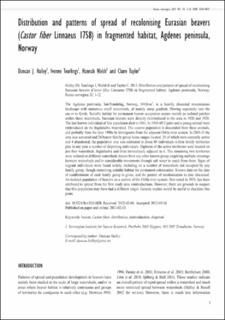| dc.contributor.author | Halley, Duncan John | |
| dc.contributor.author | Teurlings, Ivonne | |
| dc.contributor.author | Welsh, Hanna | |
| dc.contributor.author | Taylor, Claire | |
| dc.coverage.spatial | Agdenes, Norway | en_US |
| dc.date.accessioned | 2023-07-14T07:31:06Z | |
| dc.date.available | 2023-07-14T07:31:06Z | |
| dc.date.created | 2013-02-28T09:13:49Z | |
| dc.date.issued | 2013 | |
| dc.identifier.citation | Fauna Norvegica. 2013, 32 1-12. | en_US |
| dc.identifier.issn | 1502-4873 | |
| dc.identifier.uri | https://hdl.handle.net/11250/3078870 | |
| dc.description.abstract | The Agdenes peninsula, Sør-Trøndelag, Norway, 1060km2, is a heavily dissected mountainous landscape with numerous small watersheds, of mainly steep gradient, flowing separately into the sea or to fjords. Suitable habitat for permanent beaver occupation occurs mainly as isolated patches within these watersheds. Eurasian beavers were directly reintroduced to the area in 1926 and 1928. The last known individual of this population died in 1961. In 1968-69 2 pairs and a young animal were reintroduced on the Ingdalselva watershed. The current population is descended from these animals, and probably from the later 1990s by immigrants from the adjacent Orkla river system. In 2010-11 the area was surveyed and 24 beaver family group home ranges located, 20 of which were currently active and 4 abandoned; the population size was estimated at about 80 individuals within family territories plus in any year a number of dispersing individuals. Eighteen of the active territories were located on just four watersheds, Ingdalselva and three immediately adjacent to it. The remaining two territories were isolated on different watersheds distant from any other known group, requiring multiple crossings between watersheds and/or considerable movements through salt water to reach from them. Signs of vagrant individuals were found widely, including on a number of watersheds not occupied by any family group, though containing suitable habitat for permanent colonisation. Known data on the date of establishment of each family group is given, and the pattern of recolonisation to date discussed. An isolated population of beavers on a section of the Orkla river system, first noted in 1933, has been attributed to spread from the first study area reintroductions. However, there are grounds to suspect that this population may have had a different origin. Genetic studies would be useful to elucidate this point. beaver, Castor fiber, distribution, reintroduction, dispersal, Agdenes, Sør-Trøndelag, Norway | en_US |
| dc.description.abstract | Distribution and patterns of spread of recolonising Eurasian beavers (Castor fiber Linnaeus 1758) in fragmented habitat, Agdenes peninsula, Norway | en_US |
| dc.language.iso | eng | en_US |
| dc.rights | Navngivelse-Ikkekommersiell 4.0 Internasjonal | * |
| dc.rights.uri | http://creativecommons.org/licenses/by-nc/4.0/deed.no | * |
| dc.subject | beaver | en_US |
| dc.subject | Castor fiber | en_US |
| dc.subject | distribution | en_US |
| dc.subject | reintroduction | en_US |
| dc.subject | dispersal | en_US |
| dc.title | Distribution and patterns of spread of recolonising Eurasian beavers (Castor fiber Linnaeus 1758) in fragmented habitat, Agdenes peninsula, Norway | en_US |
| dc.title.alternative | Distribution and patterns of spread of recolonising Eurasian beavers (Castor fiber Linnaeus 1758) in fragmented habitat, Agdenes peninsula, Norway | en_US |
| dc.type | Peer reviewed | en_US |
| dc.type | Journal article | en_US |
| dc.description.version | publishedVersion | en_US |
| dc.rights.holder | © 2013 The Authors | en_US |
| dc.source.pagenumber | 1-12 | en_US |
| dc.source.volume | 32 | en_US |
| dc.source.journal | Fauna Norvegica | en_US |
| dc.identifier.doi | 10.5324/fn.v31i0.1438 | |
| dc.identifier.cristin | 1015208 | |
| dc.relation.project | Norges forskningsråd: 193818 | en_US |
| cristin.unitcode | 7511,2,0,0 | |
| cristin.unitname | Avdeling for terrestrisk økologi | |
| cristin.ispublished | true | |
| cristin.fulltext | original | |
| cristin.qualitycode | 1 | |

